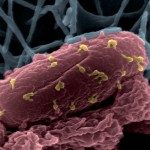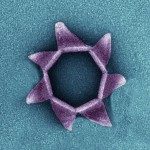Lien vers Pubmed [PMID] – 17158678
J. Bacteriol. 2007 Mar;189(5):1496-504
The Serratia marcescens hemophore is secreted by a type I secretion system consisting of three proteins: a membrane ABC protein, an adaptor protein, and the TolC-like outer membrane protein. Assembly of these proteins is induced by substrate binding to the ABC protein. Here we show that a hemophore mutant lacking the last 14 C-terminal amino acids is not secreted but rather interacts with the ABC protein and promotes a stable multiprotein complex. Strains expressing the transporter and the mutant protein are sensitive to detergents (sodium dodecyl sulfate [SDS]). TolC is trapped in the transporter jammed by the truncated substrate and therefore is not present at sufficient concentrations to allow the efflux pumps to expel detergents. Using an SDS sensitivity assay, we showed that the hemophore interacts with the ABC protein via two nonoverlapping sites. We also demonstrated that the C-terminal peptide, which functions as an intramolecular signal sequence in the complete substrate, may also have intermolecular activity and triggers complex dissociation in vivo when it is provided as a distinct peptide. The SDS sensitivity test on plates enables workers to study type I secretion protein association and dissociation independent of the secretion process itself.


